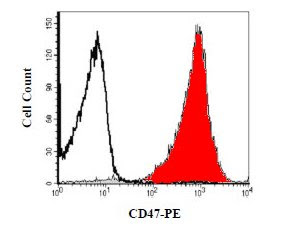Introducing the new mouse NK Cell Isolation Kit [Catalog# MAGM210]:

Example of enrichment of NK cells from mouse Balb/C splenocytes using MagCellect Mouse NK cell enrichment kit (R&D Systems MAGM210). Cells before (panel A) and after (panel B) enrichment were double-stained with APC-conjugated anti mouse CD49b (DX5) and PE-conjugated anti mouse NKp46 (R&D Systems Cat.# FAB2225P) to specifically label the NK cell population. Note that two small populations with CD49dim/NKp46- and NKp46dim/CD49b- staining are also enriched (panel C)
Phenotypic characterization of MagCellect-isolated mouse NK cells

MagCellect (MAGM210)-isolated NK cells were characterized by NK-specific staining with PE-conjugated anti-mouse NKp46 (R&D Systems Cat.#) and anti-mouse NKG2D (R&D Systems Cat.#), and with APC-conjugated anti-mouse CD49b (R&D Systems Cat.#) antibodies. Cells were analyzed by flow cytometry.
Comparing the new MagCellect NK Isolation kit with other commercially available systems
First, we tested our new MagCellect NK cell kits by comparison to other systems in the market, with typically better or similar results. But while other commercially available kits require a costly set of magnets and supplies (i.e, expensive columns), MagCellect is simpler and more cost-effective
here's how our kit's performance compares to that a column-based magnetic isolation system:

Balb/C mouse NK cells were isolated from 50 million splenocytes using either R&D Systems (MAGM210) or a competitor's column-based magnetic system. All reagents used (kit reagents, magnets, magnetic beads and columns)were from the respective makers. All isolations were performed according to the given manufacturer's instructions.
MagCellect performed similarly or better in all tests, it is faster, and it is more cost-efficient (you don't have to buy expensive disposable columns).
Second, we tested our new MagCellect NK cell kit in combination with other suppliers' magnets.
We realize that some people already invested large amounts of money in costly magnets and supplies from our competitors, so we developed our MagCellect kits to be able to work with optimal performance using different type of magnets and supplies.
Here's how our MagCellect mouse NK Isolation kit (MAGM210) performed using two magnets from other makers, Miltenyi and StemCell Technologies:

Balb/C mouse NK cells were isolated from 50 million splenocytes using R&D Systems NK isolation kit (Cat# MAGM210) used in combination with either A) R&D Systems magnet (Cat# MAG997), B) Miltenyi Biotec magnet (Cat# 130-042-302) and LS columns (Cat# 130-042-401) or C) StemCell Technologies magnet (Cat# 18000)
MagCellect kit was used with excellent results using any of the leading magnets currently in the market. If your lab already owns a Miltenyi Biotec or StemCell Technology magnet, you can safely switch to using MagCellect with optimal results and in a more cost-efficient manner. Unlike other commercially available kits that require a costly set of magnets and supplies, our kits were developed to work with different kind of commercially available magnets and systems, providing more flexibility, simplicity and cost-efficacy.




















